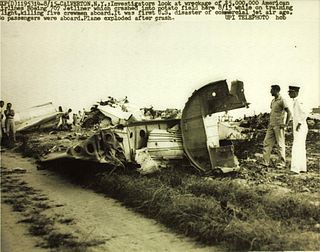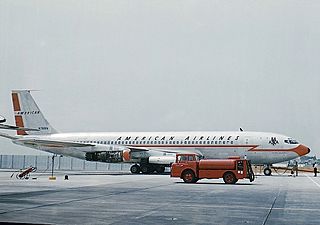
China Airlines Flight 006 was a daily non-stop flight from Taipei to Los Angeles International Airport. On 19 February 1985, the Boeing 747SP operating the flight was involved in an aircraft upset accident, following the failure of the No. 4 engine, while cruising at 41,000 ft (12,500 m). The plane rolled over and plunged 30,000 ft (9,100 m), experiencing high speeds and g-forces before the captain was able to recover from the dive, and then to divert to San Francisco International Airport.

TWA Flight 841 was a scheduled passenger flight from John F. Kennedy International Airport in New York City, en route to Minneapolis-Saint Paul International Airport in Minneapolis, Minnesota. On April 4, 1979, at or around 9:48 p.m. Eastern Standard Time, while flying over Saginaw, Michigan, the Boeing 727-31 airliner began a sharp, uncommanded roll to the right, and subsequently went into a spiral dive. The pilots were able to regain control of the aircraft and made a successful emergency landing at Detroit Metropolitan Airport.

Alliance Air Flight 7412 was a scheduled Indian domestic passenger flight from Calcutta to Delhi, operated by Indian regional airliner Alliance Air. On 17 July 2000, while on approach to its first stopover in Patna, the Boeing 737-2A8 operating the route nose-dived and crashed into a residential area in Patna, killing 60 people including 5 on the ground.

BOAC Flight 712 was a British Overseas Airways Corporation (BOAC) service operated by a Boeing 707-465 from London Heathrow Airport bound for Sydney via Zurich and Singapore. On Monday 8 April 1968, it suffered an engine failure on takeoff that quickly led to a major fire; the engine detached from the aircraft in flight. After the aircraft had made a successful emergency landing, confusion over checklists and distractions from the presence of a check pilot contributed to the deaths of five of the 127 on board. The direct cause of the fire was the failure of a compressor wheel, due to metal fatigue.

On 4 October 1992, El Al Flight 1862, a Boeing 747 cargo aircraft of the then-state-owned Israeli airline El Al, crashed into the Groeneveen and Klein-Kruitberg flats in the Bijlmermeer neighbourhood of Amsterdam, the Netherlands. The crash is known in Dutch as the Bijlmerramp.
In aviation, a preflight checklist is a list of tasks that should be performed by pilots and aircrew prior to takeoff. Its purpose is to improve flight safety by ensuring that no important tasks are forgotten. Failure to correctly conduct a preflight check using a checklist is a major contributing factor to aircraft accidents.

Trans World Airlines Flight 800 was an international scheduled passenger service from Kansas City, Missouri to Cairo, Egypt via Chicago, New York City, Paris, Milan, Rome, and Athens. The Boeing 707 crashed during take off on runway 25 at Leonardo da Vinci–Fiumicino Airport, Rome at 13:09 GMT on a flight to Athens International Airport, Greece on 23 November 1964.
Several aviation incidents and accidents have occurred in which the control surfaces of an aircraft became disabled, often due to failure of hydraulic systems or the flight control system. Other incidents have occurred where controls were not functioning correctly prior to take-off, either due to maintenance or pilot error, and controls can become inoperative from extreme weather conditions. Aircraft are not designed to be flown in such circumstances; however, a small number of pilots have had some success in flying and landing aircraft with disabled controls.

LOT Polish Airlines Flight 16 was a Boeing 767 passenger jet on a scheduled service from Newark, United States, to Warsaw, Poland, that on 1 November 2011 made a successful gear-up emergency landing at Warsaw Chopin Airport, after its landing gear failed to extend. All 231 aboard survived without serious injuries. A leak in one of the aircraft's hydraulic systems occurred shortly after takeoff, resulting in the loss of all of the hydraulic fluid supplying the primary landing gear system.

American Airlines Flight 514 was a training flight from Idlewild International Airport, to the Grumman Aircraft Corp. airfield. On the afternoon of August 15, 1959, the Boeing 707 operating the flight crashed near the Calverton airport, killing all five crew members aboard. This was the first accident to involve a Boeing 707, which had only gone into service in October of the previous year, and the first of three accidents involving American's 707s in the New York area within three years.

American Airlines Flight 1502 was a crew training flight from Idlewild International Airport. On January 28, 1961, the Boeing 707 operating the flight crashed out of control into the Atlantic Ocean 9.5 miles (15.3 km) west of Montauk Point, New York, and all six crew on board were killed. The cause of the crash was never officially determined. Flight 1502 would be the second of three 707s that American lost in a three-year period in the New York area.

Sriwijaya Air Flight 062 (SJ062/SJY062) was a scheduled domestic passenger flight, operated by Indonesian airline Sriwijaya Air from Soekarno-Hatta International Airport, Jakarta to Sultan Thaha Airport, Jambi. On 27 August 2008, the aircraft operating the flight, a Boeing 737 series 200 registered as PK-CJG, overran the runway and crashed onto a house during its landing attempt at Jambi. Due to the accident, 26 people were injured, including 3 people on the ground. One person later succumbed to his injuries. Everyone on board the aircraft survived the crash. It was the first fatal crash in Sriwijaya Air's operational history and was the only fatal accident until Sriwijaya Air Flight 182 crashed in 2021.

On 17 March 1977 a British Airtours Boeing 707 being used for pilot training crashed and caught fire during its take-off roll at Glasgow Prestwick Airport. All four crew members on board survived.

Pan Am Flight 799 was an international cargo flight from Los Angeles International Airport to Cam Ranh Airport in South Vietnam that crashed on December 26, 1968, near Anchorage, Alaska. The aircraft involved was a Boeing 707-321C aircraft operated by Pan American World Airways. All three crew members died in the crash.

On April 21, 1985, Eastern Air Lines Flight 494 was a domestic flight from Hartsfield-Jackson Atlanta International Airport (ATL) to Piedmont Triad International Airport (GSO) using a McDonnell-Douglas DC-9. Shortly after takeoff, the flight experienced an uncommanded deployment of reverse thrust on the #2 engine. Flight 494 is one of the few recorded instances of an aircraft recovering safely from unintentional deployment of reverse thrust on one engine during flight.

Delta Air Lines Flight 9877 was a crew training flight operated on a Douglas DC-8. On March 30, 1967, it lost control and crashed into a residential area during a simulated engine-out approach to Louis Armstrong New Orleans International Airport.

The 1991 RAAF Boeing 707 crash occurred on 29 October 1991, resulting in the loss the aircraft and all five crew members. The aircraft, serial number A20-103 with callsign Windsor 380, was on a training flight involving a demonstration of the aircraft's handling characteristics at minimum control speeds in a "double asymmetic" condition, with two of its four engines at idle power. During the non-approved manoeuvre, the aircraft stalled and entered a spin before crashing into Bass Strait off Woodside Beach, Victoria. The subsequent inquiry highlighted serious deficiencies in the RAAF's documentation and training, as well as operational knowledge of the aircraft type. It was the first fatal accident of a swept-wing jet transport in the country and remains the largest aircraft to have crashed in Australia.















